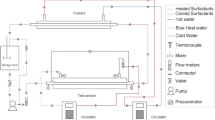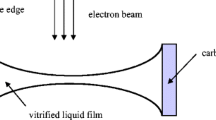Abstract
There is considerable interest in the use of viscoelastic cationic surfactant-counterion mixtures in district heating and cooling systems to reduce pressure losses. A recent field test in a secondary system near Prague showed a 30+% reduction in pumping energy requirements.
We have studied a number of commercial surfactants and we report here results of rheological, drag reduction and turbulence measurements on Arquad 18–50 (octadecyl trimethyl ammonium chloride (AR 18)) with an excess of sodium salicylate (NA). The concentration studied was 1.6 mM AR 18 and 4.0 mM NA which is about one third the concentration for excellent drag reduction in this surfactant's effective temperature range 30–90°C.
Viscosity, η, vs. shear rate,D, first normal stress difference,N 1, vs. shear rate, drag reduction (as pressure drop,i=ΔP/1) vs. average velocity,U ave, in a 39.4 mm tube for AR 18, and turbulence intensity data for three drag reducing surfactants are reported.
Of particular interest are the generally low turbulence intensities in all three directions which correspond to reduced heat, mass and momentum transfer rates compared to water, and the existence of large normal stress differences at 20°C for AR 18, a temperature at which no drag reduction occurs with this surfactant, indicating that normal stress effects do not correlate directly with drag reduction.
The effect of time of pumping on increasing drag reduction demonstrates that this factor overwhelms the expected increase in drag reduction as temperature is raised from 18–19°C to 40.5°C.
Similar content being viewed by others
References
Althaus, W., Anwendung widerstandsvermindernder Additive in Fernwärmesystemen, Dissertation, Universität Dortmund (1991).
Hammer, F., Smooth water for district heating.Fernwärme International — FWI 22 (1993) 4.
Aslanov, I.V., Maksutenko, S.N., Povkh, I.L., Simonenko, A.P. and Stupin, A.B., Turbulentnye techenia rastvorov poverkhnostno-aktivnykh vesczestv, Izv. Acad. Sci. USSR,Mechanika zhidkosti i gaza 1 (1980) 36–43.
Pollert, J., Zakin, J.L., Myska, J., Kratochvil, P., Use of friction reduction additives in district heating system field test at Kladno-Kročehlavy, Czech Republic. In:Proc. Intern. District Heating and Cooling Assoc., Seattle, WA (1994) pp. 141–156.
Stern, P., Myska, J., Lu, B., Smith, B.C., Chou, L.C., Zakin, J.L., Relationship of flow birefringence and normal stresses of cationic surfactant systems to their turbulent friction reduction characteristics. In:Proc. 4th European Rheology Conf., Seville (1994) pp. 605–608.
Chara, Z., Zakin, J.L., Severa, M., Myska, J., Turbulence measurements of drag reducing surfactant systems.Experiments in Fluids 16 (1993) 36–41.
Hoffmann, H., Hofmann, S., Rauscher, A. and Kalus, J. (1991) Shear-induced transitions in micellar solutions.Progr. Colloid Polym. Sci. 84 (1991) 24–35.
Hofmann, S., Stern, P. and Myska, J. Rheological behavior and birefringence investigations on drag-reducing surfactant solutions of tallow-(tris-hydroxyethyl)-ammonium acetate/sodium salicylate mixtures.Rheol. Acta 33 (1994) 419–430.
Ohlendorf, D., Interthal, W. and Hoffmann, H., Surfactant systems for drag reduction: Physicochemical properties and rheological behaviour.Rheol. Acta 25 (1986) 468–486.
Myska, J., Stern, P. and Chara, Z., Rheological properties of strained drag reducing surfactants.Acta Techn. CSAV 38 (1993) 535–545.
Vissman, K. and Bewersdorff, H.W., The influence of preshearing on the elongational behavior of dilute polymer and surfactant solutions.J. Non-Newtonian Fluid Mech. 32 (1990) 289–317.
Myska, J. and Stern, P., Properties of a drag reducing micelle system.Colloid Polym. Sci. 272 (1994) 542–547.
Chou, L.C., Drag reducing cationic surfactant solution for district heating and cooling systems. Dissertation, The Ohio State University, Columbus (1991).
Myska, J., Stepanek, P. and Zakin, J.L., Micellar size of drag reducing cationic surfactants. Manuscript in preparation.
Chára, Z., Myška, J., Severa, M. and Zakin, J.L. LDA investigation of turbulent characteristics of drag reducing surfactant systems.J. Hydrol. Hydromech. 42(2–3) (1994) 141–150.
Virk, P.S., Turbulent kinetic energy profile during drag reduction.Phys. Fluids 18 (1975) 415–419.
Virk, P.S., Mickley, H.S. and Smith, K.A., The ultimate asymptote and mean flow structure in Toms' phenomenon.Trans. of the ASME J. Appl. Mech. 37 (1970) 488–493.
Lu, B. Dissertation, The Ohio State University, Columbus (in progress).
Patterson, G.K., Turbulence measurements in polymer solutions using hot-film anemometry. Dissertation, University of Missouri-Rolla, Rolla (1969).
Author information
Authors and Affiliations
Rights and permissions
About this article
Cite this article
Myska, J., Zakin, J.L. & Chara, Z. Viscoelasticity of a surfactant and its drag-reducing ability. Appl. Sci. Res. 55, 297–310 (1995). https://doi.org/10.1007/BF00856637
Received:
Accepted:
Issue Date:
DOI: https://doi.org/10.1007/BF00856637




